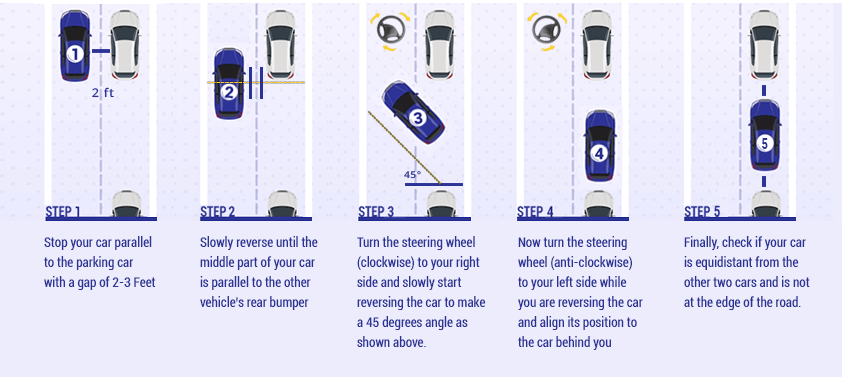
If you get sweaty palms just thinking about parallel parking, trust us, you are not the only one. Many drivers feel the same pressure when they have to align and park the car without causing any damage to other cars.
Parallel car parking is a hard skill to master because of how intricate it is. And yet, it is an essential driving manoeuvre that you must know of to park in tight spaces that you encounter in day to day driving.
Here is all that you need to know about parallel parking, which along with the on-road practice, will help you master the art with ease.
Parallel parking is a method of parking a car in line with other parked vehicles on one side of the road and facing in the same direction as traffic on that side. To do this, one has to slightly drive past the available parking space and pull up next to the parked vehicle, then gradually reverse to fit in the space whilst keeping a safe distance.
This may sound a little tricky, but there is no need to get nervous. With concentration and some practice, one can easily master the technique of parallel car parking.
Being a precise driving manoeuvre, parallel parking hinges on following the right approach. Here are the four steps to parallel park your car.
Step 1: Find the right fit
In parallel parking, you should not just park in the very first space spotted. It requires careful analysis of the available parking space to see if your car will fit there. As a thumb rule, the parking space should be one and a half times the length of your car. Only then should you pull up or else keep looking until a suitable space is available. Once the right spot is found, stop your car parallel to the car you are going to park behind. Maintain a distance of 2-3 feet while doing so.
Step 2: Put it in reverse
Next, slowly reverse until the middle part of your car is parallel to the other vehicle’s rear bumper. At this point, your car will start changing direction to slot behind the car in front. The benefit of maintaining distance will become evident here; you’ll have enough space to reverse without risking any contact between your car and the other vehicle.
Step 3&4: Slot your car into position
Now, cut the steering wheel towards the right to achieve a 45° angle and continue in reverse gear. Then, turn the steering wheel anti-clockwise and continue reversing until your car is perfectly aligned with the rest of the vehicles, and parallel to the wall or divider on the driver’s side.
Note: The same approach will be applicable when you are parallel parking your car on the left. In this case, the left side of your car will be parallel to the wall, divider or any such boundary.
Step 5: Straighten and align
The final step is to check if your car is at an equal distance from the cars in front and behind, and the edge of the road. If not, then reposition your car until it is in the center and demonstrates perfectly parallel lines.
Is it surprising for you to see other drivers flawlessly parallel park their car? Here are the 5 must-know parallel parking tips to help you get there.
1. Use Your Indicators
Always keep your indicator (whether left or right) switched on while you are parallel parking the car to let other drivers know about your intended turn. Remember that this is the only way to communicate with other vehicles on the road. Hence, use your indicators wisely while parallel parking your car.
2. Put your IRVM and ORVMs To Good Use
There are quite a few possibilities of blind spots when parallel parking. Hence, always keep an eye on both using your IRVM (Inside Rear View Mirror) and ORVMs (Outside Rear View Mirror) to check for any risks or obstacles while reversing the car.
3.Slowly Back Up
Rushing is never a good idea on the road especially when parallel parking. Keeping in line with the thought, slowly and gradually reverse your car as you slot your car into the empty parking space.
4.Maintain Control of the Steering Wheel
Parallel parking is all about how swiftly and smartly you turn the steering wheel whilst having full control of it. Remember to place your hands in the nine and three-position at all times and let the wheel spin freely with both your hands on it as much as possible to maintain good control.
5.Finalise Your Position
While keeping your car as close to the wall or divider as possible, you also need to ensure that there’s ample room left in front and behind for other vehicles to easily pull in and out of their respective parking spaces without the risk of damage.
When the divider or wall is on the driver side while parallel parking, leave enough room for the right side doors to open for you and your co-passengers to get in and out.
Remember, the more you practice using these tips to parallel park, the easier it becomes to master the art without any sweaty palms or the risk of bumping into other parked cars while you are parallel parking your car.